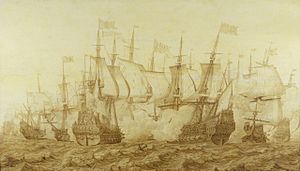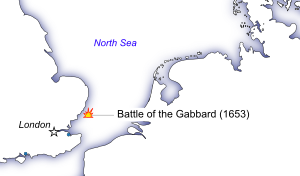Battle of the Gabbard facts for kids
Quick facts for kids Battle of the Gabbard |
|||||||
|---|---|---|---|---|---|---|---|
| Part of First Anglo-Dutch War | |||||||
 The Battle of the Gabbard, 2 June 1653 by Heerman Witmont |
|||||||
|
|||||||
| Belligerents | |||||||
| Commanders and leaders | |||||||
| George Monck Richard Deane † John Lawson William Penn |
Maarten Tromp Witte de With |
||||||
| Strength | |||||||
| 100 ships | 98 ships | ||||||
| Casualties and losses | |||||||
| 126 dead & 236 wounded | 6 ships sunk 11 ships captured 1,350 prisoners |
||||||
The Battle of the Gabbard was a big naval battle that happened on June 2–3, 1653. It was fought during the First Anglo-Dutch War, which was a conflict between the Commonwealth of England (England at the time) and the Dutch Republic (the Netherlands). This battle took place near the Gabbard Bank, a sandbar off the coast of Suffolk, England. It was a very important victory for the English.
The Battle Begins
The English fleet had 100 ships. They were led by brave commanders like George Monck and Richard Deane. On the other side, the Dutch fleet had 98 ships. Their main leaders were Lieutenant-Admiral Maarten Tromp and Vice-admiral Witte de With.
On June 2, 1653, the Dutch ships attacked first. But the English had a clever plan. They used "line-of-battle" tactics. This means their ships formed a long line, one after another. This allowed them to fire all their powerful cannons at the Dutch ships. The Dutch tried to get close and board the English ships, but the English guns were too strong. The Dutch fleet, which had lighter ships, was badly damaged and lost two ships on the first day.
The Second Day of Fighting
On June 3, the English got even stronger when Admiral Robert Blake joined them with more ships. Even though his ships were running low on ammunition, Admiral Tromp decided to attack again.
But then, the wind suddenly died down. This made the Dutch ships almost stop moving. They became easy targets for the English ships, which had better and heavier guns. The English chased the Dutch fleet for a long time, capturing many of their ships.
English Victory and Its Impact
By the end of the battle, the Dutch had lost 17 ships in total. Six of their ships were sunk, and eleven were captured. The English didn't lose any ships, but General Richard Deane was sadly killed. This was one of the worst defeats in Dutch naval history.
This big English victory meant they now controlled the English Channel and the North Sea. After the battle, the English set up a "blockade" around the Dutch coast. This meant they stopped Dutch merchant ships from coming and going. This blockade hurt the Dutch economy very badly. The two fleets would meet again later that year in another big battle.
News of the English victory was celebrated with great excitement in London. It was the first major naval battle England had won in a long time.
See also
- HMS Gabbard of the British Royal Navy was named in honour of the battle.


